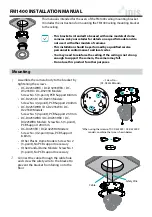
0
3.0m
2.0m
1.0m
3.0m
2.8m
2.6m
2.4m
2.2m
2.0m
1.0m
0
3.0m
2.0m
1.0m
3.0m
2.8m
2.6m
2.4m
2.2m
2.0m
1.0m
0
3.0m
2.0m
1.0m
3.0m
2.8m
2.6m
2.4m
2.2m
2.0m
1.0m
0
3.0m
2.0m
1.0m
3.0m
2.8m
2.6m
2.4m
2.2m
2.0m
1.0m
0
3.0m
2.0m
1.0m
3.0m
2.8m
2.6m
2.4m
2.2m
2.0m
1.0m
0
3.0m
2.0m
1.0m
3.0m
2.8m
2.6m
2.4m
2.2m
2.0m
1.0m
3
3. Setting the Row with the
Dipswitch 8
(for only OA-2V/OA-205V-2).
Pattern when Base Angle 10
Adjusting the Pattern Depth
Setting the Sensitivity
Normally set to “M.”
“H” increases the sensitivity and “L” lowers the sensitivity.
Setting the Presence timer
1st Row from door provide
the presence detection.
(1) Select the presence timer.
(2) Turn the power off and on again. Otherwise it may leave
door open for the duration of the presence time set.
(3) After making sure that the door closes, wait for 10
seconds before entering the detection area to set the
Presence timer.
Setting the Frequency Function
(Interference Prevention)
Four different frequencies
can be set by adjusting
the Dipswitch 3 and 4.
Note
When two or more sensors are installed close to each other,
it is possible that they interfere. When that happens,
change the Frequency.
Setting the immunity mode
Set the Dipswitch5 if the
sensor is used in a region
with snow or a lot of insects.
2. Setting the Depth Angle
between -4 to 4 (1 per click)
by Adjustment Screw.
Shallow
Depth
Setting the 1st Row detectable timer
(For only OA-2VF)
Select the 1st Row
detection time
by adjusting the
Dipswitch 7 and 8.
Note
The door may close when this sensor broke down.
Entry motion
Power OFF
Outside the
Detection area
OA-1V
OA-205V-1
(image)
Sensor status
Power OFF
Stand-by
Motion Detection
Active
Entry into 2nd Row
Entry into 1st Row
Outside the
Detection area
Motion or Presence
Detection Active
Stand-by
Orange
Red
Green
Output
Operation indicator
Green
OFF
Yellow
Yellow
CHECKING
Check the operation according to the chart below.
TROUBLESHOOTING
Inform the following items to the building owner/operator
1. When turning the power on, always walk-test the sensor pattern to ensure proper operation.
2. Always keep the detection window clean. If dirty, wipe the window with a damp cloth. (Do not use any cleaner or solvent.)
3. Do not wash the sensor with water.
4. Do not disassemble, rebuild or repair the sensor yourself; otherwise electric shock may occur.
5. Contact your installer or the sales engineer if you want to change the settings.
6. Do not place an object that moves or emits light in the detection area. (Ex. Plant, illumination, etc.)
7. Do not paint the Detection Window.
Contact your installer or the sales engineer if:
- you need to change the settings or replace the sensor.
- the trouble still persists after checking and remedying as described above.
Does not
operate
Dose not
operate
consistently
Operates by
itself
(Ghosting)
Power supply is not adequate.
Connection Failure.
Dirty detection window.
Sensitivity is Low.
There is an object that moves or emits light in the
detection area. (Ex. Plant, illumination, etc.)
Vibration of the header.
Sensitivity is high.
Waterdrops on detection window.
Detection area has interfered the area of another
sensor.
The detection 1st row spots are overlapping with
the door / header.
Door stay open
or closed
There is an reflected object in the detection area.
Solar light reflects.
Presence timer is Infinity. There was an abrupt
condition change in the detection area.
Adjust to stated voltage.
Check the wiring and the connector.
Wipe the detection window with a damp cloth. (Do not
use any cleaner or solvent.)
Set the Sensitivity Switch “H.”
Set the Sensitivity Switch “L.”
Remove the object.
Remove the object.
Secure the header. Or set the Sensitivity Switch “L.”
I
nstall in a place keeping the waterdrops off. OR
use a rain-cover (Optional).
Set the different frequency position each other.
Adjust the detection area to deep (outside).
Turn the power off and on again.
Trouble
Possible Cause
Solution
There was a puddle left by rain or snow.
The floor has gotten wet.
The exhaust of the car and the fog penetrate into the
detection area.
This sensor is equipped with the anti-malfunction.
However, pay attention when installing as malfunction
may occur under the left conditions.
OPTEX CO., LTD.
(ISO 9001 Certified by LRQA)
5-8-12 Ogoto Otsu 520-0101, Japan
TEL.: +81 (0)77-579-8700 FAX: +81 (0)77-579-7030
WEBSITE: www.optex.co.jp
4
Setting of Sensitivity Switch and Dipswitches
Sensitivity Switch
Dipswitches
1 2 3 4 5 6 7 8
ON
L M H
1 2
1 2
1 2
1 2
3 4
3 4
3 4
3 4
7 8
7 8
7 8
7 8
Depth angle can be set up by two kinds, a base and an adjustment screw.
1. Setting the Base Angle.
OA-1V/OA-205V-1: between -2 to 10 .
OA-2V/2VF/OA-205V-2: between 0 to 10 .
Pattern when Base Angle 5
Pattern when Base Angle -2
+5
-5
:Adjustable Area
by Adjustment
Screw ±4°
8
8
-2 0 5 10
2ROW
1ROW
:Adjustable Area
by Adjustment
Screw ±4°
:Adjustable Area
by Adjustment
Screw ±4°
:Adjustable Area
by Adjustment
Screw ±4°
:Adjustable Area
by Adjustment
Screw ±4°
:Adjustable Area
by Adjustment
Screw ±4°
+7
-7
+5
-5
+5
-5
OA-2V
OA-205V-2
(image)
OA-2VF
(image)
During 1st Row
detectable time ,after
leaving the Detection
area
Green
1st Row detect-
able Stand-by
Pattern when Base Angle 10
Pattern when Base Angle 5
Pattern when Base Angle 0
OA-1V/OA-205V-1
OA-2V/OA-2VF/OA-205V-2
Yellow
Yellow
Yellow
Yellow
Yellow
Yellow
Yellow
Yellow
Yellow
Yellow
5
5
Normal Immunity
2sec. 15sec. 180sec.
5sec. 1
0
sec. 15sec. 20sec.
Position Position Position Position
1 2 3 4
Note
Be aware of non-detection area by the door-rail when moving the emitting spots forward too much for deeper approach.
OA-2VF does not have 1st Row spots during
stand-by. Immediately after 2nd Row spots detects,
1st Row spots appear till the 1st Row detection time
set up.
When entry into 1st Row spots or 2nd Row spots
within 1st Row detection time, even if setting time
passes, 1st Row spots continue existing.
After leaving area, and passing 1st Row detection
time, 1st ROW spots are lost again.




















